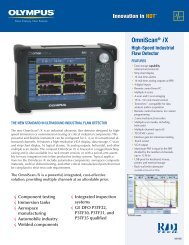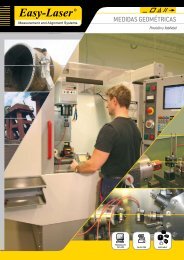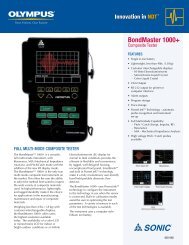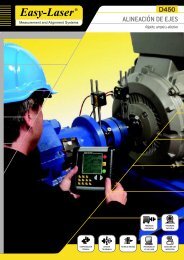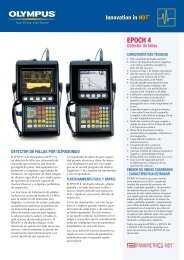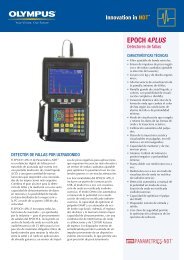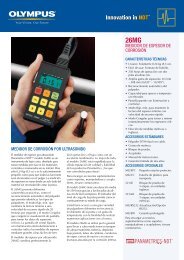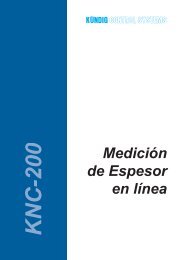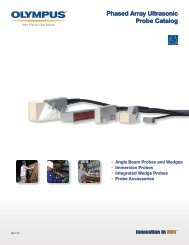Magnetic Particle Testing - Tecsud
Magnetic Particle Testing - Tecsud
Magnetic Particle Testing - Tecsud
Create successful ePaper yourself
Turn your PDF publications into a flip-book with our unique Google optimized e-Paper software.
Magnetisation techniques<br />
in accordance with DIN EN ISO 9934-1<br />
Yoke magnetisation<br />
Alternating current yoke<br />
Open W-yoke – A magnetic circuit, determined by the<br />
mains frequency of 50/60 Hz is completed through air;<br />
there is a constant field polarity reversal and with open<br />
yokes the maximum clamping length = 1000 mm.<br />
Closed W-yoke – A closed iron core is used and when<br />
the test piece is clamped the majority of the magnetic<br />
field lines are constrained within the iron core; an alternating<br />
field can therefore be maintained over a larger<br />
distance.<br />
Maximum clamping length = 1200 mm<br />
D.C. yoke<br />
Arrangement for test units with D.C. yokes<br />
Crack indications: Transverse cracks<br />
Advantages:<br />
• Robust construction<br />
• Longest possible clamping lengths<br />
Crack indication: Transverse cracks<br />
Advantages:<br />
• Uniform field distribution even with complicated<br />
shaped parts with large cross-sectional changes.<br />
• Can be adapted for induction fluxing techniques.<br />
• Simple and rapid de-magnetisation of the test<br />
piece.<br />
Disadvantages:<br />
• Expensive construction<br />
• Limited clamping length<br />
Disadvantages:<br />
• Stray field formation at the rounded ends of<br />
workpieces.<br />
• Considerable field reduction with large<br />
cross-sectional changes of the test piece.<br />
• Expensive to de-magnetise the test piece.<br />
Magnetisation with<br />
current flowing conductor<br />
Coil magnetisation (solid or moveable coil)<br />
Crack indications: Transverse cracks<br />
Indications at 90° to the magnetic field or in the<br />
current direction i.e. in accordance with the<br />
direction of the coil windings.<br />
Criteria:<br />
• When testing tubes in conjunction with alternating<br />
current, only the outside surface is magnetised.<br />
• Because the magnetic field lines are introduced at<br />
right-angles to the plane surface of the material,<br />
circular cracks may be indicated with reduced<br />
sensitivity.<br />
Straight-through-conductor<br />
(Threading bar technique)<br />
Crack indications: Longitudinal cracks<br />
Internal and external, star-like cracks running from<br />
the centre to the outside on the plane surface.<br />
Advantages:<br />
• Contactless magnetisation, and therefore no<br />
danger of burning.<br />
• When A.C. is used the tube is only internally<br />
magnetised.<br />
Direct fluxing<br />
Axial direct fluxing<br />
Crack indications: Longitudinal cracks<br />
Indications at 90° to the magnetic field or in the<br />
direction of the current i.e. in a direct line between<br />
both contact poles.<br />
Criteria:<br />
• Crack indications at the contact points not possible.<br />
• With dirty contact points there is a danger<br />
of burning.<br />
• With very high current strengths the test piece<br />
heats up.<br />
Induction fluxing<br />
Requirements for carrying out induction fluxing<br />
• Only closed ring or tube-shaped test pieces can<br />
be inspected by means of the circulating induction<br />
current.<br />
• A dynamic field is necessary for the generation of an<br />
induction current.<br />
i.e. alternating current can only be used for induction<br />
fluxing.<br />
Crack indication: Circulating defects<br />
All circulating defects, internal, external and at<br />
both plane surfaces.<br />
Advantages:<br />
• Contactless magnetisation and therefore no<br />
danger of burning.<br />
• Good possiblities of combining with indirect<br />
fluxing, for contactless detection of defects of all<br />
directions (finished part testing).<br />
11/02 · g+r<br />
Tiede GmbH + Co · Bahnhofstr. 94-98 · D-73457 Essingen · Tel. +49 (0) 73 65/81-0 · Fax +49 (0) 73 65/81-449 · info@tiede.de · www.tiede.de



